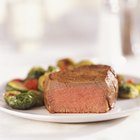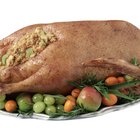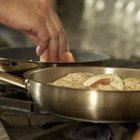Unfortunately, the fastest way to do something isn't always the best way, and such is the case with thawing turkey breast (or any other poultry, meat or seafood, for that matter). It can be done relatively quickly – in a matter of minutes, even – but not without some negative effects on the quality of the finished dish. If you have a few hours, you're in better shape, and, for future reference, planning ahead enough to defrost a whole turkey breast over the course of one to two days is optimal.
Danger!
To elaborate on why you have to be careful here, the main concern when quickly thawing a turkey breast is keeping it out of the "danger zone" between 40 and 140 degrees Fahrenheit for any longer than two hours. At this temperature, bacteria reproduces rapidly, even to the point where cooking won't eliminate all potential for foodborne illness. This is why you can't just let the breast sit out on the counter at room temperature for hours or run it under warm or hot water – two defrosting methods that are always unsafe for poultry, red meat or seafood.
The Quickest Thawing Method
The fastest way to defrost a turkey breast is in the microwave, using its defrost setting. But, as savvy cooks know, microwaves may be quick and convenient, but they often compromise the quality of food as a trade-off. It takes up to 6 minutes per pound to thaw this way, though time varies by individual microwave. Flip the whole breast over halfway through the defrost time, and if you don't have a spinning microwave plate, also rotate the breast 180 degrees a few times throughout.
Defrosting the turkey breast this way results in the outside starting to cook before it's thawed all the way through. You can limit this some by letting the turkey rest for a few minutes when it starts happening, but the exterior will probably end up overcooked by the time the breast is safely cooked through to 165 degrees Fahrenheit. This method also causes significant moisture loss from the meat, leaving you with a drier, tougher, less flavorful finished product. Keep in mind too that because of the turkey's temperature after defrosting this way, it must be cooked immediately. Never refreeze uncooked poultry, red meat or seafood that was defrosted in the microwave.
A Better but Slower Way
If you have a few hours to spend defrosting your whole turkey breast – and you'll be around to tend to it periodically – there's a preferable way to do it. It has to be in waterproof packaging for this method. Place the breast in a large bowl or dish in the sink and run cold water over it, filling the vessel. The turkey has to remain fully submerged for the duration of the thaw, which takes around 30 minutes per pound. Either leave the water running, which is a slightly quicker but not particularly conservation-friendly option, or just let the breast sit in the filled dish. If you choose the former, redirect the water over different parts of the breast once in a while; if you go with the latter, replace the water with new cold water every half hour.
This method obviously avoids the problem of the turkey starting to cook while defrosting. It also results in less moisture loss. As with microwave defrosting, though, poultry, red meat and seafood thawed in this manner must be cooked right away and can't be refrozen without being cooked first.
The Best but Slowest Way
When you can, defrost poultry, meat or seafood in the refrigerator. This yields the least moisture loss and is the safest method. But it takes time – a full day at least for a whole turkey breast and maybe even longer. It depends on the temperature in the fridge, plus each appliance has its own quirks with how cold it is in different places inside. As an added bonus, you don't have to cook the turkey right away, as it will stay safe for another day or two, and it can also be refrozen without cooking if you change your mind within this window.
Cooking a Frozen Turkey Breast
Just for the record, you don't have to thaw a whole turkey breast before cooking it in the oven, on the stove or on the grill. This saves some effort and possibly some time depending on which defrosting method you would've used. Expect it to take about 50 percent longer for the turkey to cook if it's still frozen. Also, the turkey is likely to cook a little unevenly, so you may end up with an overcooked outer layer by the time the whole breast is fully cooked through.
Related Articles
How Long to Thaw a Frozen Turkey
Is It Safe to Leave a Turkey at Room ...

How to Cook a Wild Turkey

Is Frozen Ground Beef Left out for 3 ...

What Is the Fastest Way to Cook Baked ...
Can You Cook a Turkey Halfway & Finish ...
Ideal Turkey Cooking Time by Weight

How to Bake Boneless Chicken to Stay ...

Difference in Cook Time Between Bone-in ...

How Long Can You Leave Frozen Meat Out?

Can You Defrost Hamburger in Hot Water?

How to Cook a Turkey Joint

How Much Does Meat Shrink After It Is ...

Can Roasting a Pork Roast at a Higher ...

How to Bake Goose Breasts

Can I Cook Chicken That's Been Thawed ...

Cooking Poultry With a Convection Vs. ...

Oven Roasting Tips for Baking a Rival ...

How Long Does It Take for Ground Beef ...
Difference Between Cooking in a Regular ...
References
Tips
- Cook the turkey breast immediately after thawing.
Warnings
- Never thaw a turkey breast at room temperature, as temperatures above 40 degrees Fahrenheit can lead to bacteria growth.
- Use warm, soapy water to wash your hands and any cooking utensils that come into contact with the raw turkey.
Writer Bio
Eric Mohrman is a food and drink, travel, and lifestyle writer living in Orlando, Florida. He has professional experience to complement his love of cooking and eating, having worked for 10 years both front- and back-of-house in casual and fine dining restaurants. He has written print and web pieces on food and drink topics for Visit Florida, Orlando Style Magazine, CrushBrew Magazine, Agent Magazine, Dollar Stretcher Magazine, The 863 Magazine and other publications.